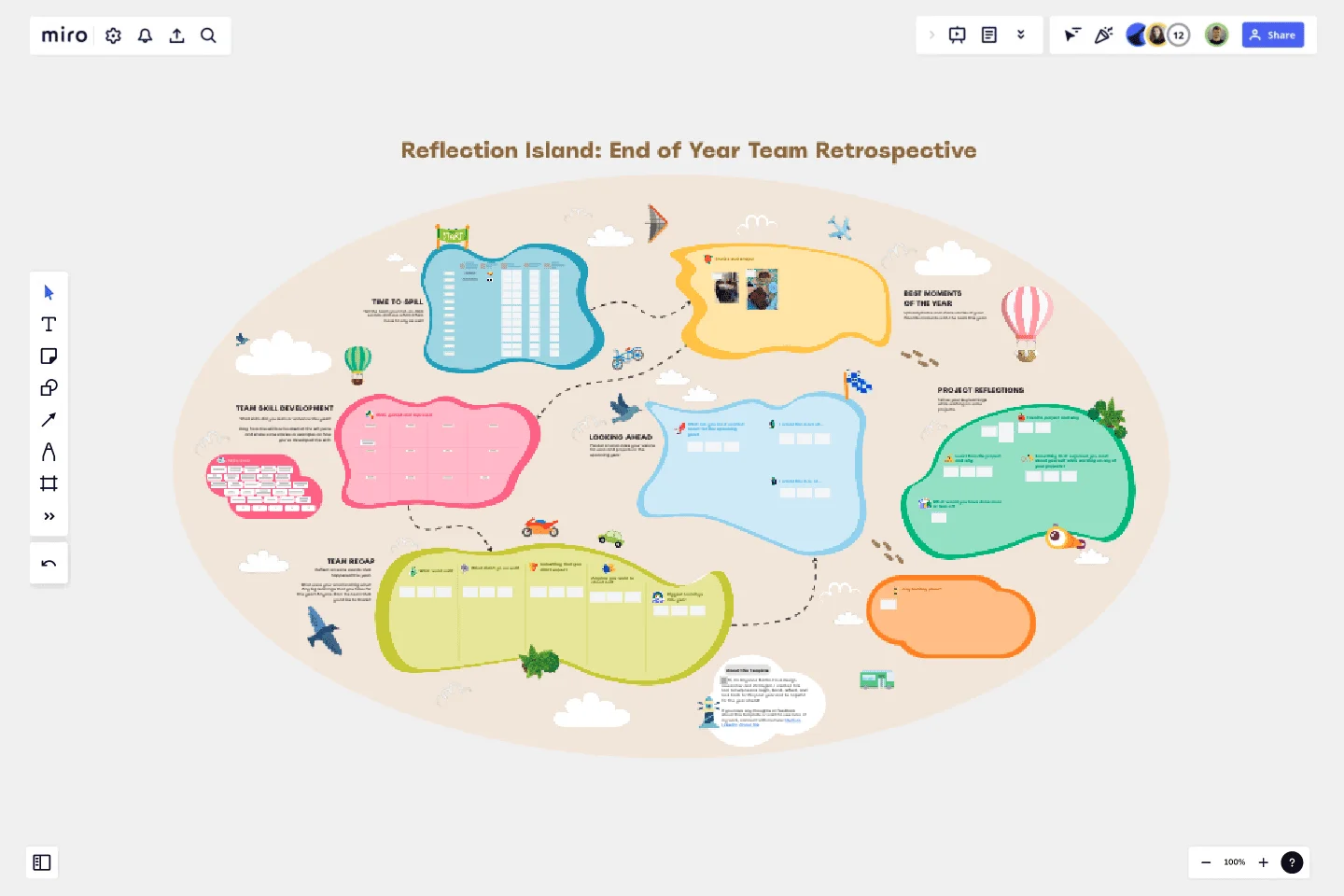Reflection Island: End of Year Team Retro
This End-of-Year Retrospective tool is aimed to help teams look back on the past year, bond, share some laughs, and be hopeful for the year ahead.
Designed with an island theme, participants will explore different parts of the island and share their thoughts and experiences.
Time to Spill: Tell the team your not-so-dark secrets (think: favorite emojis, motivational song) and see what others have to say as well.
Best Moments of the Year: Share some photos and stories of your favorite moments with the team.
Team Skill Development: Reflect on the skills that you have gained or improved this past year.
Team Recap: Share with everyone your small and big wins, some unexpected teaching moments, and a teammate that you'd like to give kudos to.
Looking Ahead: Ponder on and share your visions for work and projects this upcoming year.
Project Reflections: Share your key learnings while working on projects.
Holiday Plans: Tell what you're looking forward to this holiday season.
This tool can be tweaked to change questions or remove topics. It can also be filled out individually to be discussed as a group or fill out as part of a dedicated team retrospective meeting.
This template was created by Aryanna Martin.
Get started with this template right now.
DMAIC Analysis Template
Works best for:
Agile Methodology, Design Thinking, Operations
Processes might not seem like the funnest thing to dive into and examine, but wow can it pay off—a more efficient process can lead to serious cost savings and a better product. That’s what DMAIC analysis does. Developed as part of the Six Sigma initiative, DMAIC is a data-driven quality strategy for streamlining processes and resolving issues. The technique is broken into five fundamental steps that are followed in order: Define, Measure, Analyze, Improve, and Control.
Year in Review Template
Works best for:
Retrospectives
The Year in Review Template encapsulates an entire year's pivotal moments, achievements, and challenges. One of its standout benefits is its ability to foster deep introspection. With this template, people or teams can genuinely reflect on their experiences, ensuring that every lesson learned and every milestone achieved is recognized and used for future growth.
Product Roadmap by Petra Ivanigova
Works best for:
Product Management, Roadmap
Plan your product journey with the Product Roadmap by Petra Ivanigova. This template helps you outline key milestones, set priorities, and visualize your development path. Use it to align your team, ensure everyone is focused on the same goals, and keep stakeholders informed. Ideal for product managers and teams looking to streamline their planning process and achieve strategic objectives efficiently.
Backlog Refinement with Jira Template
Works best for:
Agile, Backlog Refinement
The Backlog Refinement with Jira template in Miro improves collaboration among team members. It provides a visual and interactive space for teams to review, prioritize, and clarify upcoming work items together in real time. This collaborative approach ensures alignment on priorities and details, leading to a more organized and efficient workflow. The seamless integration with Jira automatically syncs all changes, reducing the need for manual updates and keeping both platforms up-to-date.
Scrum Compass
Works best for:
Agile, Meetings, Workshops
The Scrum Compass is a visual tool for guiding Scrum teams through their journey. It provides a structured framework for understanding Scrum roles, events, artifacts, and values. This template offers a comprehensive overview of Scrum principles and practices, enabling teams to align on common goals, roles, and processes. By promoting clarity and alignment, the Scrum Compass empowers teams to navigate the complexities of Agile development and deliver value with confidence and efficiency.
Sailboat Template
Works best for:
Agile Methodology, Meetings, Retrospectives
The Sailboat Retrospective is a low-pressure way for teams to reflect on how they handled a project. By defining your risks (the rocks), delaying issues (anchors), helping teams (wind), and the goal (land), you’ll be able to work out what you’re doing well and what you need to improve on for the next sprint. Approaching team dynamics with a sailboat metaphor helps everyone describe where they want to go together by figuring out what slows them down and what helps them reach their future goals.
